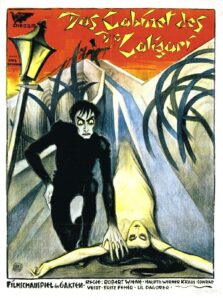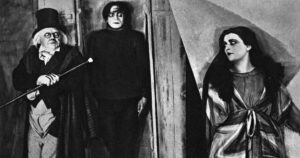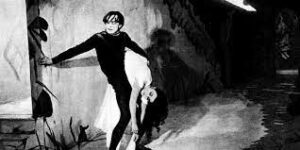“The Cabinet of Dr. Caligari” – a Masterpiece of German Expressionism

Title: “The Cabinet of Dr. Caligari”
Release Date: 1920
Director: Robert Wiene
Cast: Werner Krauss, Conrad Veidt, Lil Dagover, Friedrich Feher i inni
“The Cabinet of Dr. Caligari” proved that cinema can be an art. The film, despite being intended for an elite audience, has permanently entered the cultural canon and is still an important point of reference for contemporaries.
“The Cabinet of Dr. Caligari”
Robert Wiene made “The Cabinet of Dr. Caligari” in 1920. The film had clear artistic ambitions, the director addressed his work rather to an audience that was sensitive and familiar with modern art trends. The “Cabinet” followed expressionistic poetics, which does not mean Wiene neglected the work’s storyline. The story presented by the director is interesting, suspenseful and ambiguous.
The film tells the story of a crazy director of a mental institution who, in order to gain the power of the medieval Dr. Caligari, decides to use a sleepwalker in the hospital to commit brutal murders. However, the doctor is unmasked by a young man, Franzis (Friedrich Feher), whose friend was murdered by the somnambulist. The somnambulist also kidnaps Franzis’ fiancée Jane Olsen (Lil Dagover) and drives her insane. While conducting a private investigation, Franzis arrives at a mental institution. Nevertheless, he is tricked into being trapped and taken for a patient.

The movie has an open and clearly ambiguous ending. It is unclear whether the story Franzis is telling is true or whether it is just a delusion of a mentally ill man. The latter interpretation would be supported by the fact that the protagonist’s fiancée is also in the hospital, and the supposed Caligari in the final scene states that he already knows how to cure the sick man. On the other hand, the viewer emotionally identifies with Franzis and his version of events. So what really happened? This question the film leaves unanswered.
It is worth noting that “The Cabinet of Dr. Caligari” is clearly referenced in Martin Scorsese’s contemporary film “Shutter Island” (2010), starring Leonardo Di Caprio. The main character, Teddy, can also be both a detective investigating and a mental hospital patient who has deluded himself about the whole story.
Caligari as a premonition of impending Nazism
In contemporary reception, “The Cabinet of Dr. Caligari” functions primarily as a socio-political allegory. This interpretation was first put forward by Siegfried Kracauer in a book with the significant title “From Caligari to Hitler”. According to the scholar, the demonic Dr. Caligari is a metaphor for Kaiser Wilhelm II, who during World War I somehow captured the minds of Germans and led the nation to disaster. The character is also meant to foreshadow Hitler and his Nazi ideology. Indeed, the behavior of the Germans during World War II is reminiscent of Caesar’s somnambulist in his madness committing terrible crimes.
“The Cabinet of Dr. Caligari” – a work of German expressionism
In analyzing Robert Wiene’s “The Cabinet of Dr. Caligari”, it is impossible to ignore the film’s expressionistic poetics. We are dealing here with the transfer of the assumptions of that artistic current into film language. First of all, attention is drawn to the incredible decorations, which make the space and props create fantastic images, e.g. in Edvard Munch’s style. The whole town of Holstenwall, the individual buildings and the local market do not have a real dimension, but look like something out of a gloomy nightmare. They are formed by sloping walls, winding corridors and deformed doors.

The space is clearly distorted, as if in a distorting mirror. Moreover, it is made up of paper and painted elements; even the shadows of the characters are painted on the canvases. Thus, the scenery reflects the mood of the characters as well as the sickness of spirit of the whole community.
What is more, the space is symbolic, as a city, a prison, and a hospital for the mentally ill can be distinguished. It is a menacing and enclosed setting, emphasizing the characters’ imprisonment in the hell of their own minds. It is worth noting that in many shots the characters somehow merge with the decorations, especially in the scenes with the somnambulist. This emphasizes the objectification of the somnambulist, since he is not an independently thinking and acting human being, but a helpless tool in the hands of the demonic Dr. Caligari.
“The Cabinet of Dr. Caligari” also uses romantic motifs, especially the combination of love and madness. The love triangle of two men and a woman, for example, is psychologically interesting. Franzis and Alan are infinitely in love with the beautiful Jane. In this context, Alan’s mysterious death may seem suspicious and incriminating for the protagonist… These and other ambiguities make the film even today retain its dark atmosphere and can still fascinate.
Literature:
A.Grabicz, J. Klimowski, Kino, wehikuł magiczny. Przewodnik osiągnięć filmu fabularnego. Podróż pierwsza 1913 – 1949, Kraków 2007.

